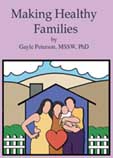Developing Your Family Style
created by Gayle
Peterson, including
Excerpts from Making
Healthy Families

When two people come together to create a family,
they each bring their own unconscious version of how family members
relate to one another. As children, we spend years growing up in our
own families, observing and imprinting upon the ways that our families,
as a particular group of people interact to solve problems, to express
feelings, to make decisions and raise their young. Our own parents
were largely responsible for the unique family culture we lived in,
and for the inlay of automatic conditioning that naturally influences
(both positively and negatively), our patterns of interactions when
a child comes on the scene in our adult lives.
When a child is born, old family styles of relating
are stimulated to reassert themselves on the new family group. Marital
partners who have basked in expressing their feelings to their partner
and being able to successfully meet one another’s needs, find
themselves falling into automatic behaviors of old childhood patterns.
Where they once spoke proudly of their open and direct communication,
their equal and respectful relationship to one another, they may nevertheless
find themselves falling back on old familiar, though unpleasant methods
of interacting (blaming, withdrawing) reminiscent of what their parents
did when dealing with conflict.
Family researchers, such as Robert Beavers, have defined
family style as “the degree of centripetal and centrifugal
qualities in the family”[1]. In identifying elements of what
contributes to healthy family relationships “centripetal”
is analagous to petals on a flower, tightly formed and organized around
a center. It is meant to describe a force of energy drawn inwards
towards its’ center. “Centrifugal” refers to the
experience of centrifugal velocity, which forces us to drift further
and further away from the center.
Healthy family styles blend characteristics of both
of these polarities at differing points on the life cycle. Young families
with small children are naturally centripetal. While families with
adolescents grow towards some incorporation of centrifugal forces.
A flexible balance is considered necessary for
healthy adjustment over time. Let’s
take a closer look at what is meant by these two polarities, how to
recognize their extremes in rigid, “dysfunctional” systems,
and what style or place on this continuum our own childhood experience
placed us?
FINDING A HEALTHY BALANCE
ON THE CENTRIPETAL-CENTRIFUGAL CONTINUUM
In the extreme, rigidly centripetal families
create a culture in which they bind together against the outside world.
Outsiders are distrusted. Only the family is perceived as safe. Family
members can express positive feelings towards one another, but repress
negative or ambivalent feelings, resulting in warmth that can often
feel false or superficial because the underlying conflict is never
truly expressed or resolved. Leave-taking may be difficult in such
a family and it is not uncommon to have an adult child return home
or never leave home, and for somatization of feelings (headaches,
aches and pains, fatigue) or scapegoating of one member to manifest
as a release valve for the repressed negative feelings in the family.
Positive feelings of love are acceptable, but anger is not tolerated.
Members may feel that to be loved they must give up a large part of
themselves. Dependency is encouraged. Individualism is punished.
In the extreme, a rigidly centrifugal system
trusts outsiders more than their own family
members, dependency is perceived as weakness and so expressions of
love and caring are repressed, while anger and even hostility are
accepted modes of relating. There is a tendency to expel children
before they reach adulthood, or for children to leave home prematurely.
Independence is encouraged and precipitous, while dependency needs
are sought elsewhere outside of the family.
Centripetal force relates to warmth in a
family and centrifugal relates to freedom or autonomy . In
a positive light, we need an integration of the polarities
of being connected and being free in order to grow into a solid and
satisfying sense of who we are. In healthy families, there
is an adjustment over time to include the dependency needs of its’
growing members, and to encourage the development of autonomy of the
individual as she or he leaves home. In healthy families, there is
also give and take. No one member of a family is overly compromised
by the needs of the others consistently. Families in which one member
overly compromises for the needs of others, ignoring his or her own
growth and development are termed “adequate” as opposed
to “optimal” by Beavers. The sacrificial or “martyred
mother “ role model falls into this category. The atmosphere
of the family is negatively influenced when other family members’
growth comes at the expense of one member repeatedly. Now for a look
at your own childhood family “ culture” and its’
impact on your current family relationships.
 Go
to: Exercise: What
are Your Family Blueprints? Go
to: Exercise: What
are Your Family Blueprints?
[1] Beavers, Robert, The Beavers System Model in Walsh, Froma
,Ed. Normal Family Processes, 2nd edition Guilford
Press, N.Y. 1993
|